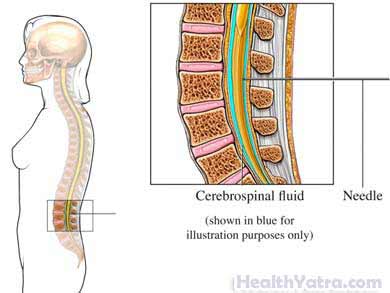Definition
Lumbar puncture is a test of the fluid around your spine and brain. This fluid is called cerebrospinal fluid (CSF). It provides protection and nutrition to the brain and nerve cells. CSF also helps to remove waste products from the brain.

Reasons for Procedure
The test is done to look for abnormalities in the spinal fluid. It may be done to help diagnose conditions such as:
- Brain infection, or infection of the layers around the brain
- Multiple sclerosis (MS)
- Any disorder affecting the nervous system
- Certain types of cancer
- Bleeding in the brain or spinal cord
- Excess CSF in the brain
The procedure may also be done to:
- Administer dye for imaging studies
- Drain CSF to lower pressure within the brain
- Give medicine directly to the spine such as chemotherapy, antibiotics, and anesthesia
Possible Complications
If you are planning to have a lumbar puncture, your doctor will review a list of possible complications. Complications may include:
- Headache
- Backache
- Bleeding, which can compress the nerve roots or spinal cord
- Pain or abnormal burning, pricking, or tingling sensations in legs
- Allergic reaction to anesthetic
- Infection
What to Expect
Prior to Procedure
Your doctor may order a CT scan of the head before the procedure. A CT scan makes detailed pictures of your brain.
Just before the procedure, your doctor will clean the site where the needle will be inserted.
Anesthesia
Local anesthesia will be used most often. It numbs just a small area. The medicine is injected with a needle.
Description of Procedure
You will lie on your side with your knees drawn up in front. Some punctures may be done while you sit on the edge of the bed. A needle will be inserted into the spinal canal through the lower back. The doctor will take a sample of CSF through the needle.
During the procedure, your doctor will make a note of the pressure of the CSF. If you have discomfort, the needle may need to be repositioned. It may take several minutes to collect the fluid needed. The needle will be removed. A dressing will be placed over the puncture.
Immediately After Procedure
You will lie down for 10-15 minutes. In most cases you will be able to go home after the procedure. If you have a severe headache or require immediate treatment, you may need to stay longer.
How Long Will It Take?
About 30-45 minutes from setup to completion
Will It Hurt?
Discomfort is minimal to moderate. The anesthetic will sting when first injected.
Post-procedure Care
When you return home after the procedure, do the following to help ensure a smooth recovery:
- Drink extra fluids for the next 24 hours.
- Rest and remain quiet for at least 24 hours.
- Be sure to follow your doctor’s instructions.
Call Your Doctor
After arriving home, contact your doctor if any of the following occurs:
- Severe headache or headache lasting for more than 24 hours
- Nausea or vomiting
- Signs of infection, including fever and chills
- Redness, swelling, increasing pain, bleeding, or discharge from the lumbar puncture site
- Numbness, tingling, or pain in your lower back or legs
- Weakness in your lower legs or difficulty walking
- Problems with urination or defecation
- A stiff neck
- Pain that you cannot control with the medicines you have been given
In case of an emergency, call for medical help right away.
